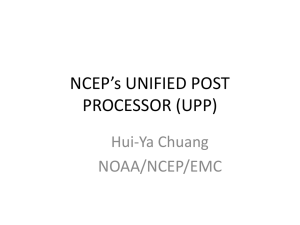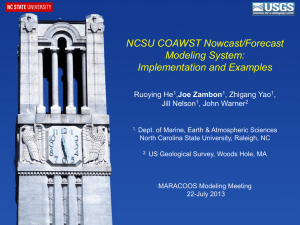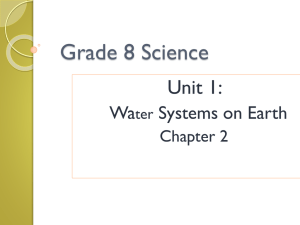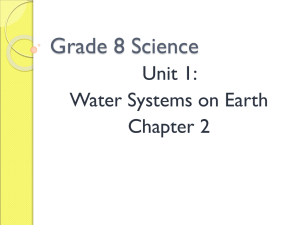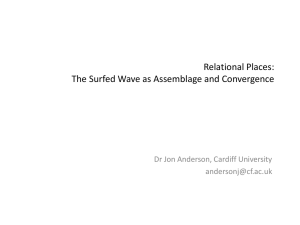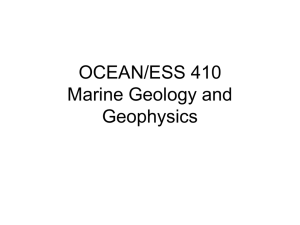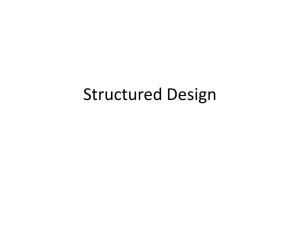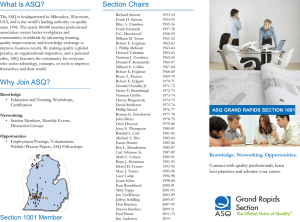Thursday-5-Kim-HWRFJan2014
advertisement
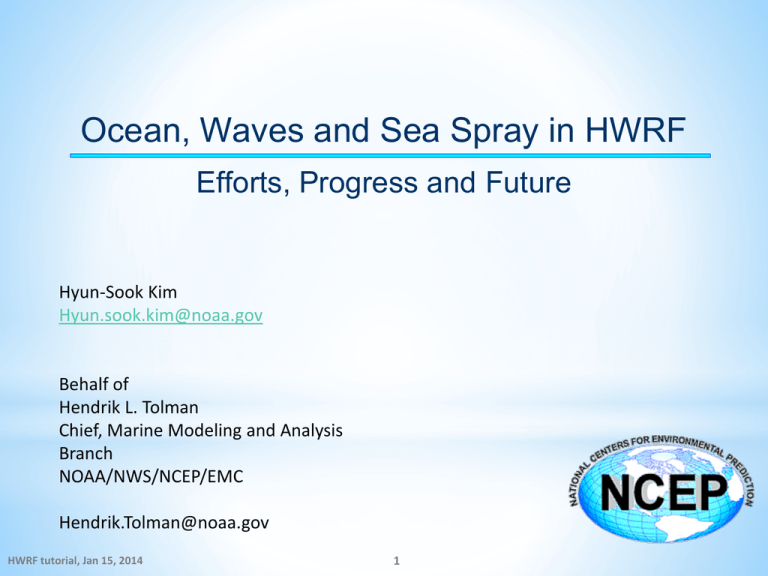
Ocean, Waves and Sea Spray in HWRF Efforts, Progress and Future Hyun-Sook Kim Hyun.sook.kim@noaa.gov Behalf of Hendrik L. Tolman Chief, Marine Modeling and Analysis Branch NOAA/NWS/NCEP/EMC Hendrik.Tolman@noaa.gov HWRF tutorial, Jan 15, 2014 1 Hurricane modeling team at EMC V. Tallapragada and team (7 + leveraging EMC ≈ 5). Original GFDL hurricane model coupled to POM ocean model in operations since 2005. Main justification is to improve intensity forecast. Now in HWRF hurricane model. Presently with POM model coupling from GFDL since 2007. Moving to HYCOM coupling. In Progress and Future: 3-way coupling - Add wave coupling in collaboration with URI and U. Miami. NOAA Environmental Modeling System (NEMS) framework – Earth System Modeling Framework (ESMF) compliance in collaboration with NLR and U. Miami HWRF tutorial, Jan 15, 2014 2 2-way coupling HWRF-HYCOM Coupled hurricane modeling with regional ocean components (future HYCOM application, since 2009) N. Atlantic Current: W. Pacific Future - basin HWRF parent E. Pacific HWRF tutorial, Jan 15, 2014 3 Typhoon Forecasts for the 2012 and 2013 season HWRF-HYCOM (cpl) vs. HWRF (ctl) 2-way coupling Track Verification Component Mean Error Absolute Mean Error The differences in TC track between Coupled (cpl) and persistent SST (ctl) forecasts are very small. Analysis of the individual components suggests that the tracks have a southwestward bias, but having ocean coupled corrects this bias. cf. southward bias (Khain and Ginis, 1991) or northward bias (Bender et al. 1993) for a westward moving storm. HWRF tutorial, Jan 15, 2014 4 Typhoon Forecasts for the 2012 and 2013 seasons HWRF-HYCOM (cpl) vs. HWRF (ctl) Intensity verification HWRF-HYCOM (cpl) shows smaller error especially later forecast hours, cf non-coupled (ctl). Mostly, negative bias in 2-way coupling Vmax Absolute Error Bias Absolute Error Bias Pmin Vmax, and positive Pmin. Pmin-Vmax relationship: Skillful Pmin simulations at Vmax 2012 range between 25 and 100 kt. Under- prediction of Pmin for both lower and high Vmax. Seasonal Performance: HWRF better for 2012 and HWRF-HYCOM better for 2013 HWRF tutorial, Jan 15, 2014 5 Vmax. vs. Pmin 2013 2-way coupling SST Analysis Comparison against daily TMI & AMSRE OI SST Day 5 Day 1 Obs. HYCOM in cpl • Similar cold wake (~26oC) at a similar degree of cooling (~3oC) • Mesoscale variability GFS SST GFS in ctl statistics @day 5 for Jelawat 18W: cycle=2012092200 HYCOM HWRF tutorial, Jan 15, 2014 HYCOM SST GFS 6 • No change in GFS SST. • No cold wake and no cooling • No Mesoscale variability HYCOM SST • Similar magnitude of mean • Higher correlation coefficient (0.899) • Lower RMSD (0.6) and STD (0.5). 2-way coupling Analysis of Storm size , asymmetric wind pattern, and Heat flux HWRF-HYCOM (cpl) HWRF (ctl) Jelawat 18W 48 forecast hr IC: 2012/09/24 00Z On footprint of Each panel : 1000 km radius Latent Heat (top left) 0~1100; Sensible Heat (top right) -200~200; LH+SH (bottom) -200~1200 HWRF-HYCOM cf. HWRF: Size - Smaller Wind Pattern – Asymmetric SST feedback plays significant. Magnitude - Smaller HWRF tutorial, Jan 15, 2014 7 2-way coupling Preliminary Conclusion Maximum Potential Intensity (MPI) (coupled) HWRF-HYCOM compared to (non-coupled) HWRF: Emanuel (2003) 1. Smaller storm size on average, and Contracting with time. 2. Asymmetric wind pattern. 3. Slower translation speed. 4. Lower surface enthalpy. 5. HYCOM SST cooler than GFS. 6. Meso-scale dominant. 2 max V (T1 T2 ) Fh Cd T2 T1 = SST; T2 = outflow temperature; Cd = drag coefficient; and Fh = (LHT+SHT) the surface flux of enthalpy. T1, LHT, SHT, Cd and (Ch) are either explicitly or implicitly related with SST. Coupling w/ an ocean model results in the SST feedback. A good example is shown. Hence, re-considered are: 1. Sub-grid parameterization in both the atmospheric and oceanic components; 2. Optimizing air-sea flux parameters to two-way coupling system, e.g. Cd & Ch. 3. Or, employing three-way coupling. HWRF tutorial, Jan 15, 2014 8 HWRF-POM/HYCOM-WaveWatchIII Coupling HWRF tutorial, Jan 15, 2014 9 3-way coupling HWRF three-way coupled Air-Sea Interface Module (ASIM) URI 3-way coupling ASIM implemented in HWRF includes the following physical processes affected by surface waves: • Hurricane model surface stress includes effects of sea state, directionality of wind and waves, sea spray, and surface currents. • Wave model forced by sea state-dependent wind stress and includes effects of ocean currents. • Ocean model forced by sea state-dependent wind stress, modified by growing or decaying wave fields and Coriolis-Stokes forcing. turbulent mixing is modulated by the Stokes drift (Langmuir turbulence) HWRF tutorial, Jan 15, 2014 10 URI 3-way coupling Atmosphere SST Uc Qair Uref Rair τair τdiff Ocean τcor Uc λ α γ Hs Rib Uλ Cp Waves α - Charnock coefficient γ - Misalignment (wind angle - stress angle) λ - Mean wavelength Hs – significant wave height Cp – wave age SST – Sea surface temperature τCoriolis-Stokes - Coriolis-Stokes stress τdiff - Surface wave momentum budget τair - Wind Stress at wave height Uref - wind vector at reference height 𝐔λ- wind vector at reference height Uc - current vector Qair – Heat Flux Rair – air moisture HWRF tutorial, Jan 15, 2014 11 Effects of surface waves on ocean currents and turbulence URI 3-way coupling Turbulence closure(modified by wave effects) ASIM momentum flux budget : wave-dependent momentum flux budget terms (Fan et al. 2010) S - wave spectrum : Coriolis-Stokes forcing term (Polton et al. 2005) f - Coriolis parameter : Langmuir turbulence effect – will be included in the turbulence closure model (in collaboration with Kukulka, U. Delaware) HWRF tutorial, Jan 15, 2014 12 URI Wind profile in Wave Boundary Layer (WBL) 3-way coupling Wind shear is not aligned with wind stress. Wind profile is explicitly solved, and the misalignment angle (γ) is determined. RHG method (Reichl et al. 2013) Energy input: From wind shear Adapted from Hara and Belcher (2004) Wave Boundary Layer Dissipation: Parameterized from turbulent stress Wave energy uptake: From spectrum and growth-rate HWRF tutorial, Jan 15, 2014 13 Cd vs. Wind for different ASIM parameterization options 3-way coupling ASIM includes three sea-state dependent Cd parameterization options tested here using an empirically-driven wave spectrum from the Joint North Sea Wave Project (Elfounhaily et al. 1997). HWRF tutorial, Jan 15, 2014 14 URI URI Sea state dependent Cd 3-way coupling Ψ - Wave spectrum • Form drag is obtained by integrating the 2D wave spectrum times growth rate over all wavenumbers and directions. • The short wave spectral tail and growth rate are parameterized in ASIM using different theoretical and empirical methods. HWRF tutorial, Jan 15, 2014 15 ASIM momentum flux budget terms In idealized hurricane HWRF tutorial, Jan 15, 2014 16 URI 3-way coupling Investigation of sea-state dependent Cd Idealized hurricane URI 3-way coupling (A) UT = 5 m/s Wind speed (m/s) Cd (E-03) Hs (m) (B) UT = 10 m/s Wind speed (m/s) HWRF tutorial, Jan 15, 2014 Cd (xE-03) Hs (m) 17 Misalignment btwn sfc stress and wind shear Misalignment btwn sfc stress and wind shear URI 3-way coupling Results: GFDL-POM-WW3 35-m Cd vs 35-m Wind (m/s) Coupled Uncoupled Z0 (m) vs 35-m Wind (m/s) Coupled HWRF tutorial, Jan 15, 2014 Uncoupled 18 URI 3-way coupling Results: GFDL-POM-WW3 Hurricane Irene (IC=08/23/2011 12Z) Vmax Track Obs. Coupled Uncoupled HWRF tutorial, Jan 15, 2014 19 Lessons learned For coupled HWRF (2-way): Focus on best possible description of physical states for all models. Deal with de-tuning of model due to “improved” physics in two ways, which makes most sense. Deal with this as bias treatment in coupler (quick and dirty). Retune as possible, particularly when individual processes are documented to describe nature better (long term systematic approach). We need to have a set of metrics for HWRF that reflects this, track and intensity alone will never work. HWRF tutorial, Jan 15, 2014 20 Lessons learned Lessons learned: Coupled model makes further development of modeling system a little more complicated. This is an unavoidable side effect of doing things physically better. The key for this kind of coupled modeling is in the fluxes. A weather model with a fixed or climatological SST is constrained in terms of systematic seasonal – climate shifts, but, In a coupled model, there is no constraint to the ocean state. Hence, Spurious drifts of the SST and mixed layer in general in the ocean will result in spurious drifts in the weather model, with a strong possibility of (nonlinear) feedback HWRF tutorial, Jan 15, 2014 21 Lessons learned Better physics makes for a better model. But …, better physics in a well tuned model will almost always detune the model. Developing this coupled model is a cyclic process: First emphasis on getting the ocean right, In the process, we found many issues with HWRF. Not necessarily major issues for HWRF, but critical for realistic coupling with a realistic ocean model. POM appears less sensitive to these errors as ocean responses are suppressed to gain a more robust system. Fixes and updates in the HWRF model require a revisit to make sure that all ocean responses are realistic. …. and this will never stop ….. HWRF tutorial, Jan 15, 2014 22 HWRF-HYCOM example Coupling HWRF weather model to HYCOM ocean model. Regional ocean model nested in basin scale ocean model. Basin scale ocean model set up to work well with GFS fluxes. HWRF fluxes are systematically different from GFS fluxes resulting in SST drift issues: No drift in RTOFS ← GFS. Drift in RTOFS ↔ HWRF. Short term fix in coupler. Successful. Eventually, correct the HWRF fluxes (since 2012) Long term NWS issue Will require collaboration. Courtesy Hyun-Sook Kim and Jamese Sims HWRF tutorial, Jan 15, 2014 23 HWRF-HYCOM example Ocean GCM Wind waves Atmosphere GCM Coupler Needed modification in coupler for HWRF-HYCOM coupling (and any other ocean). Coupler needs to know which atmosphere and ocean models are used. HWRF tutorial, Jan 15, 2014 24 Winds / waves example So, coupling gives you better resolution of parameters in time, and therefore gives a better wave model. Unresolved in time Resolved in time wind waves However, if you go to high spatial resolution coupled modeling, time scales of coupling also become smaller, and ……. 25 HWRF tutorial, Jan 15, 2014 This, and not coupling physics is the reason why the coupled wave-weather model at ECMWF gives improved wave prediction. Waves in a traditional model become higher and higher and less and less reliable, but …. If wind fields are smoothed before passing them on to the wave model, wave model behavior remains reliable. Winds examples Ocean GCM Wind waves Atmosphere GCM Coupler Coupler needs to know scales in atmosphere used for waves. Or wave model physics need to be modified to account for wind scales resolved. Generic coupler needs both. HWRF tutorial, Jan 15, 2014 26 Lessons learned As mentioned before: Better physics should result in better models. But there are more subtle reasons too: Coupling forces you to take a closer look at details of the constituent models, in ways that are often complimentary to the way the models are conventionally validated. ECMWF wave-atmosphere coupling. This often leads to systematic improvement of the constituent models, that often has a positive impact on the constituent models, even if the impact on the actual coupling is found to be minimal. HYCOM - HWRF coupling. HWRF tutorial, Jan 15, 2014 27 Future: Challenge for HWRF NOAA Environmental Modeling System (NEMS) team at EMC Mark Iredell and team (4 + EMC + OAR + Navy + … ). Earth System Modeling Framework (ESMF): USA federal coupling standard This is the basic framework / architecture. Either core of the model, or wrapper around existing software. Courtesy of Chen (2013) HWRF tutorial, Jan 15, 2014 28


